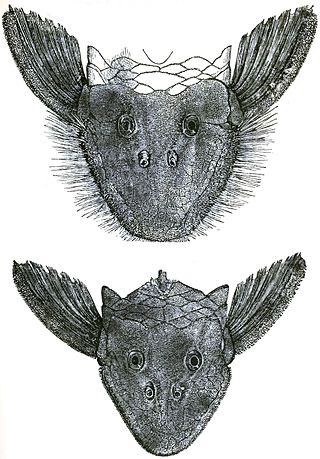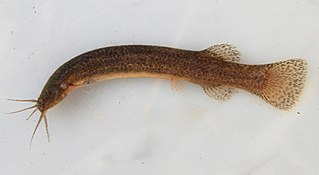
Candiru, also known as cañero, toothpick fish, or vampire fish, is a species of parasitic freshwater catfish in the family Trichomycteridae native to the Amazon Basin where it is found in the countries of Bolivia, Brazil, Colombia, Ecuador, and Peru.

Loricariidae is the largest family of catfish, with 92 genera and just over 680 species. Loricariids originate from freshwater habitats of Costa Rica, Panama, and tropical and subtropical South America. These fish are noted for the bony plates covering their bodies and their suckermouths. Several genera are sold as "plecos", notably the suckermouth catfish, Hypostomus plecostomus, and are popular as aquarium fish.

Hypostomus is a genus of catfish in the family Loricariidae. They are native to tropical and subtropical South America. H. plecostomus is the popular freshwater aquarium fish formerly known as Plecostomus plecostomus. The taxonomic structure of the Loricariidae is still being expanded by scientists. Hypostomus is a highly species-rich and widely distributed catfish genus.

Trichomycteridae is a family of catfishes commonly known as pencil catfishes or parasitic catfishes. This family includes the candiru fish, feared by some people for its alleged habit of entering into the urethra of humans. They are one of the few parasitic chordates. Another species is the life monsefuano which was important to the Moche culture and still an important part of Peruvian cuisine.

The Aspredinidae are a small South American family of catfishes also known as the banjo catfishes, with about 43 species.
Listrura is a genus of pencil catfishes native to South America.

Pseudancistrus is a genus of suckermouth armored catfishes native to South America.

Trichomycterus is a genus of fish in the family Trichomycteridae, the largest genus of its family with over 170 species currently described. This genus is native to freshwater habitats in Central and South America. These fish are generally small, usually about 5 to 15 cm (2–6 in) in standard length, although the largest, T. rivulatus, can reach more than twice this size. Species differ from one another primarily in body proportions, fin ray counts and colouration. Despite their relatively small size, some, such as T. punctulatus, support fisheries and are important in the local cuisine.

Loricarioidea is a superfamily of catfishes. It contains the six families Trichomycteridae, Nematogenyiidae, Callichthyidae, Scoloplacidae, Astroblepidae, and Loricariidae. Some schemes also include Amphiliidae. This superfamily, including Amphiliidae, includes about 156 genera and 1,187 species.

The Hypoptopomatinae are a subfamily of catfishes of the family Loricariidae, composed of 17 genera and approximately 80 species. This subfamily represents about one-tenth of all loricariid species.
Acanthopoma annectens is a species of catfish of the family Trichomycteridae, and the only species of the genus Acanthopoma. This fish grows to about 12 centimetres (4.7 in) SL and originates from the upper and middle Amazon River. This species is parasitic, attacking like a leech and leaving wounds all over the fish which it attacks; it spreads a bundle of opercular and inter-opercular spines into the wound and remains there and is difficult to remove. It may invade parts of wading or swimming animals but apparently exist in these passages only for a short while, as they quickly die from a lack of oxygen.

Eremophilus mutisii is a species of catfish of the family Trichomycteridae, and the only member of its genus. This fish grows to about 30 centimetres (12 in) and originates from the Bogotá River basin, which is a tributary of the Magdalena River. It has probably been introduced to Ubaté, Chiquinquirá, and Tundama valleys, Colombia.
Ammoglanis is a genus of pencil catfishes native to South America.
The Glanapteryginae are a subfamily of catfishes of the family Trichomycteridae. It includes four genera, Glanapteryx, Listrura, Pygidianops, and Typhlobelus.
The Sarcoglanidinae are a subfamily of catfishes of the family Trichomycteridae. It includes six genera: Ammoglanis, Malacoglanis, Microcambeva, Sarcoglanis, Stauroglanis, and Stenolicmus.

Henonemus is a genus of pencil catfishes native to South America.

Homodiaetus is a genus of pencil catfishes native to South America.

Ituglanis is a genus of small freshwater fish in the family Trichomycteridae native to South America. Their greatest diversity seems to occur in the Amazon River basin. Most species inhabit leaf litter, with several species living in caves.

The Trichomycterinae are a subfamily of catfishes of the family Trichomycteridae. It includes six genera, Bullockia, Hatcheria, Rhizosomichthys, and Eremophilus, all monotypic, Silvinichthys with two species, and Trichomycterus, with over 100 species. The former five genera are diagnosed by putatively apomorphic characters, whereas Trichomycterus is defined by the lack of those specializations and is likely not monophyletic. This subfamily has historically served as much of a wastebasket for trichomycterids that lack the specializations of the other subfamilies. Species of Trichomycterinae dwell in headwaters and small, cold clear water streams running over stony beds. Due to the patchy distribution of their habitats, trichomycterines generally have restricted geographic distributions, thus display a high level of endemism.
The Copionodontinae are a subfamily of catfishes of the family Trichomycteridae. It includes two genera, Copionodon and Glaphyropoma.














